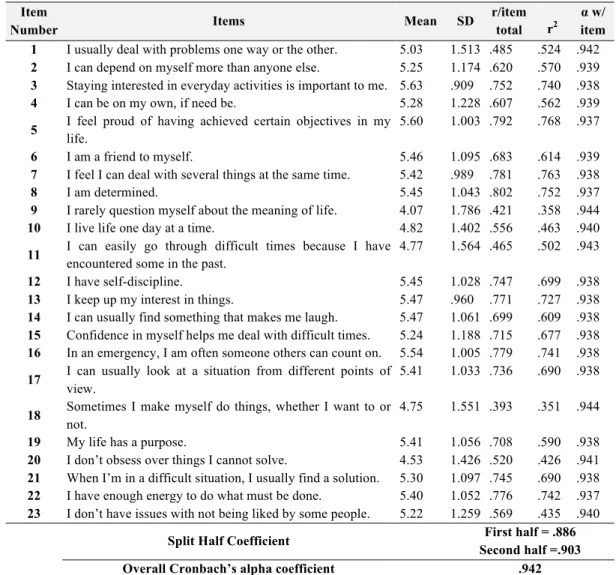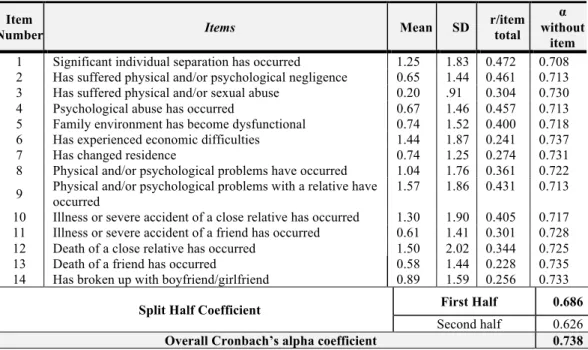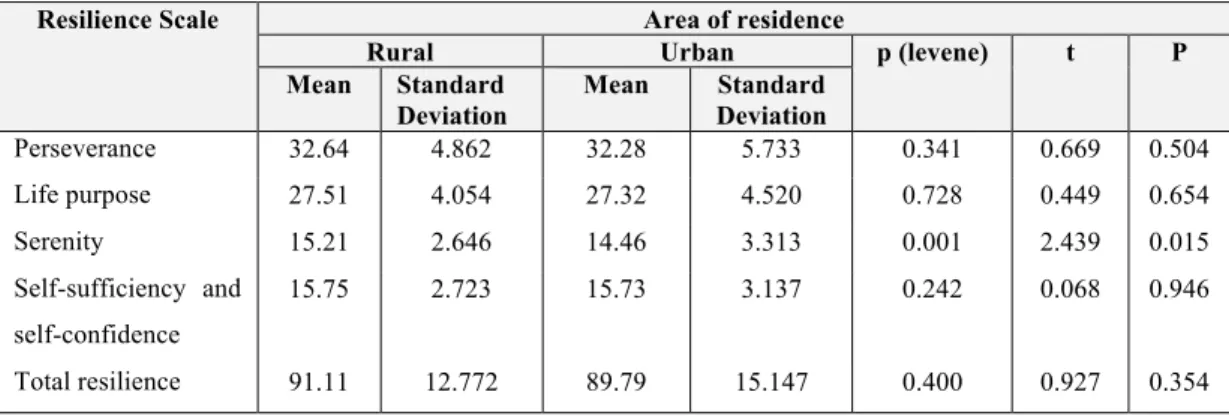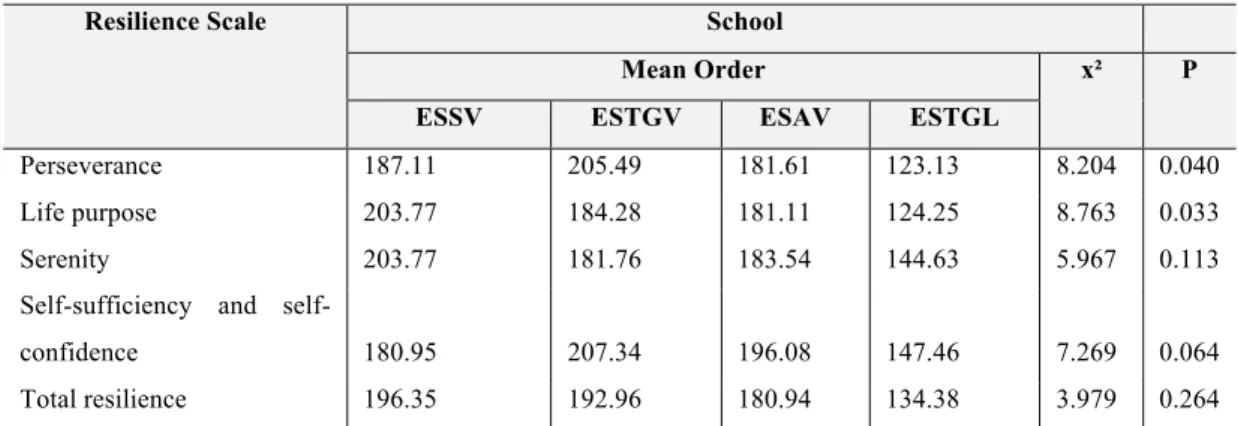This is an Open Access article distributed under the terms of the Creative Commons Attribution-Noncommercial 4.0 Unported License, permitting all non-commercial use, distribution, and reproduction in any medium,
EJSBS Volume XIX
(eISSN: 2301-2218)Negative Life Events and Resilience in Higher Education
Students
Amadeu Matos Gonçalves
a∗, Lídia do Rosário Cabral
a, Manuela da
Conceição Ferreira
a, Maria da Conceição Martins
a, João Carvalho Duarte
aaHealth School, Polytechnic Institute of Viseu, R. D. João Crisóstomo Gomes de Almeida, nº 102 – 3500-843, Viseu, Portugal
http://dx.doi.org/10.15405/ejsbs.211
Abstract
Resilience is the capacity to overcome life adversities in a positive and constructive manner. The transition from high school to a higher education degree might function as an enhancer of crises and vulnerabilities. Negative Life Events (NLE) constitute any adverse circumstances against human development, possibly threatening the individual’s equilibrium. Our aim was to study how negative life events affect the resilience of higher education students, and to identify certain socio-demographic, family and academic variables, as well as negative life events they may have endured.A quantitative study based on a descriptive design sampled 382 students from a higher education institute in Portugal. In order to assess the proposed variables, Wagnild and Young’s Scale of Resilience (1993) which was adapted for the Portuguese population by Carvalho and Pereira (2012) and the Negative Life Events Inventory (Gonçalves, 2014) was utilised. We found significant relationships between the capacity for resilience and age, marital status, area of residence, school, and the use of drugs. Regarding life events, the dimensions “Neglect”, “Separation/Loss” and “Friend Satisfaction” were found to be strong predictors of resilience capacity. The results obtained show that higher negative life events indicate a student is better able to be self-sufficient and self-confident and have higher resilience. These results lead us to propose interventions which may facilitate the students’ ability to overcome their problems.
∗ Corresponding author. Tel.: +0-000-000-0000 ; fax: +0-000-000-0000 . E-mail address: agoncalvessv@hotmail.com
© 2017 Published by Future Academy www.FutureAcademy.org.uk
Keywords: Resilience, negative life events, higher education; students.
1. Introduction
Life events are described as objective occurrences of sufficient magnitude to alter the usual activities of most people. These events translate objective experiences that disturb or threaten individuals’ usual activities forcing them to readjust their behaviour (Bras & Cruz, 2008). There are two key components of life events: on the one hand, they are discrete, discontinuous and occur across the individual’s life; on the other hand, they lead to changes in the individual’s course of life. These changes affect the individual’s overall equilibrium, requiring effort to adapt. The most common negative life events (NLE) which occur among higher education students are disciplinary issues, significant losses, break-ups, parental divorce and unwanted pregnancies (Canavarro & Lima, 2006).
NLEs are one of the main risk factors in an individual’s psychosocial adaptation because of their emotional impact and their potential to weaken coping strategies. The heterogeneity of responses and different degrees of emotional impact are related to the nature of the stressful events, the meaning assigned to them, the social and family support to deal with them and with individual characteristics and strategies. NLEs are sources of stress and therefore require individuals to react more or less intensely to adapt to them, and their impact depends on individual strategies and social resources available. It is, however, worth considering that individuals do not react in the same way to the same stress factors. This always depends on the meaning each individual gives them, as well as individual adaptive strategies (resilience) and external assistance.
Studies in this area highlight the role of the experience of negative life events (NLE), certain personality traits, specific cognitive styles and insecure bonding patterns as risk behaviour factors in college students (Brás & Cruz, 2008). Experiencing negative events and the specific way they contribute to the emergence of emotional and behavioural problems is still a topic open for research and discussion.
The concept of resilience has been studied by several authors who believe that it refers to the ability each individual has to deal with problems that arise throughout the life cycle. The roots for
the term refers to something positive, which becomes stable with consistent adaptation in challenging conditions. Recent research has considered resilience a specific field with particular features such as academic, emotional, relational, among others.
Academic resilience deserves special attention because it is directly related to academic success despite environmental adversities brought on by the initial impact, circumstances and experience. In other words, resilient students have higher levels of motivation and performance in the presence of adverse events. Therefore, motivation may be seen as the focal point for educational resilience (Jowkar, 2014).
In an educational context, resilience plays a key role as it is through resilience that students measure their strength in the face of adversity/difficulties not only academically, but also in their relationship with their peers and teachers where demanding situations will need to be faced, which may lead to moments of confrontation. This will allow students to better understand their potential and capacity to become stronger, learn and respond effectively.
2. Research Questions
This research focuses on studying how negative life events experienced by students during the transition to the university affects their problem solving skills, or in other words, their resilience. In this sense, the following research questions emerged:
i) What type of relationship can be expected between negative life events (NLE) and the students’ resilience?
ii) What is the relationship between resilience and certain sociodemographic and academic variables?
3. Research Methods
This study was performed on a non-probabilistic sample by convenience, since the sample of students belongs to the Institute where the researchers teach, which allowed a more accessible data collection process. This sample was composed of 382 students from a higher education school in Portugal. Wagnild & Young’s Resilience Scale (1993) adapted by Carvalho and Pereira (2012), was chosen to measure resilience since it was the most suitable scale to approach the research’s purpose: assessing the positive psychosocial adaptation levels on adverse situations and
identification of the degree of individual resilience as a positive personality trait and as a promoter of adaptation. This scale is divided into seven theoretical categories: Separation from significant
people; Negligence; Physical and sexual abuse; Psychological abuse; Dysfunctional family environment; Adverse life conditions; and Health problems.
3.1. Description and psychometric study of the instruments
As mentioned above, in order to assess the levels of positive psychosocial adaptation towards adverse events, Wagnild & Young’s Scale translated and adapted by Carvalho and Pereira (2012) was utilised. This scale comprises 23 items, each scored in a Likert-type scale from 1 (totally disagree) to 7 (totally agree), and distributed through 4 factors, namely:
Factor I – Perseverance – refers to persistence in finding solutions for problems, overcoming adversity and continuing to reconstruct life, while trusting oneself with an attitude of self-discipline (scale items – 7, 12, 15, 16, 17, 21, 22).
Factor II – Life purpose – refers to the awareness that there is something positive to live for, a notion that life has meaning, avoiding obsession with unsolvable issues, involving determination and satisfaction in accomplishing defined goals (scale items – 3, 5, 8, 13, 14, 19).
Factor III – Serenity – a balanced and focused perspective of one’s own life purposes, with the ability to accept the wide range of experiences, even antagonistic ones, in a serene and enthusiastic manner (scale items – 6, 9, 10, 11, 20).
Factor IV – Self-sufficiency and self-confidence – the sense of uniqueness; the awareness that each individual’s path in life is unique and certain stages are faced individually. This factor also refers to the belief in oneself and one’s skills, interest in one’s own life, while recognizing one’s limitations (scale items – 1, 2, 4, 18, 23).
The resilience scale revealed a good internal consistency (overall α=0.942) with satisfactory Cronbach’s alpha coefficient values for each of the factors: 0.839 (Factor I); 0.814 (Factor II); 0.604 (Factor III); and 0.672 (Factor IV). It is worth mentioning that resilience is not linear, since it may vary throughout life depending on the situations the individual is subjected to (Deep & Pereira, 2012).
Table 1. Internal consistency of the Wagnild and Young’s Scale of Resilience (1993) Item
Number Items Mean SD
r/item
total r2 α w/ item
1 I usually deal with problems one way or the other. 5.03 1.513 .485 .524 .942
2 I can depend on myself more than anyone else. 5.25 1.174 .620 .570 .939
3 Staying interested in everyday activities is important to me. 5.63 .909 .752 .740 .938
4 I can be on my own, if need be. 5.28 1.228 .607 .562 .939
5 I feel proud of having achieved certain objectives in my
life.
5.60 1.003 .792 .768 .937
6 I am a friend to myself. 5.46 1.095 .683 .614 .939
7 I feel I can deal with several things at the same time. 5.42 .989 .781 .763 .938
8 I am determined. 5.45 1.043 .802 .752 .937
9 I rarely question myself about the meaning of life. 4.07 1.786 .421 .358 .944
10 I live life one day at a time. 4.82 1.402 .556 .463 .940
11 I can easily go through difficult times because I have
encountered some in the past.
4.77 1.564 .465 .502 .943
12 I have self-discipline. 5.45 1.028 .747 .699 .938
13 I keep up my interest in things. 5.47 .960 .771 .727 .938
14 I can usually find something that makes me laugh. 5.47 1.061 .699 .609 .938
15 Confidence in myself helps me deal with difficult times. 5.24 1.188 .715 .677 .938
16 In an emergency, I am often someone others can count on. 5.54 1.005 .779 .741 .938
17 I can usually look at a situation from different points of
view.
5.41 1.033 .736 .690 .938
18 Sometimes I make myself do things, whether I want to or
not.
4.75 1.551 .393 .351 .944
19 My life has a purpose. 5.41 1.056 .708 .590 .938
20 I don’t obsess over things I cannot solve. 4.53 1.426 .520 .426 .941
21 When I’m in a difficult situation, I usually find a solution. 5.30 1.097 .745 .690 .938
22 I have enough energy to do what must be done. 5.40 1.052 .776 .742 .937
23 I don’t have issues with not being liked by some people. 5.22 1.259 .569 .435 .940
Split Half Coefficient First half = .886
Second half =.903
Overall Cronbach’s alpha coefficient .942
To study negative life events, an adapted version of the Negative Life Events Inventory (NLEI) by Brás & Cruz (2008) was utilised due to its value when studying frequency, impact and severity of negative events experienced by teenagers and young adults. The NLEI was scored in a Likert-type scale with 14 possible items assessed between zero (0) to five (5): 0 – No impact/consequence; 1 – Negative yet somehow positive; 2 – Slightly negative; 3 – Moderately negative; 4 – Quite negative; 5 – Extremely negative. This inventory includes the following categories/dimensions:
Separation from significant others – which includes intermittent separations (neither presence
nor absence were continuous), prolonged separations (longer than 3 months) and definitive separations;
Physical or psychological negligence – refusal or ineffectiveness in satisfying food, clothing,
hygiene and healthcare needs; refusal/ineffectiveness in providing adequate attention, care or protection;
Physical or sexual abuse – contemplates different degrees of physical abuse, namely mild
aggression to the body (e.g. slapping), moderate aggression to the body (e.g. punches, kicks) and severe aggression (capable of inducing trauma), as well as episodes of sexual abuse (e.g. forced viewing of sexual intercourse, sexual stimulation against the individual’s will and forced sexual intercourse);
Psychological abuse – a set of situations such as disparagement (being insulted by third parties
seeking to diminish the individual’s value), rejection (negative answer, abandonment and emotional coldness), humiliation (disparagement of personal qualities, usually in public), disproportionate punishment, disproportionate expectations (having high expectations and psychological pressure) and verbal or written threats to the individual’s physical or psychological integrity;
Dysfunctional family environment – comprises family conflicts with close relatives, separation
and/or threats of separation as well as substance abuse (drugs or alcohol) by the caretakers;
Adverse life situations – which includes economic difficulties and change of residence,
educational problems, change of school and poor housing conditions;
Health problems – the individual’s or relatives’ physical or psychological problems, including
illness or a severe accident involving close relatives and/or friends, death of a relative, death of a close friend,or break-up.
Table 2 shows the correlation statistics obtained within each item, with the overall value and Cronbach’s alpha. The means vary from 0.20 in item 3 “Has suffered physical and/or sexual
abuse” to 1.57 in item 9 “Physical and/or psychological problems have occurred with a relative”,
which indicates the items are well centred.
As for the Cronbach’s alpha values, they vary between 0.708 in item 1 “Significant individual
separation has occurred” and 0.737 in item 6 “Has experienced economic difficulties” and
Table 2. Internal consistency of the items from the Negative Life Events Scale (Brás and Cruz, 2008) Item
Number Items Mean SD r/item total
α without
item
1 Significant individual separation has occurred 1.25 1.83 0.472 0.708 2 Has suffered physical and/or psychological negligence 0.65 1.44 0.461 0.713 3 Has suffered physical and/or sexual abuse 0.20 .91 0.304 0.730 4 Psychological abuse has occurred 0.67 1.46 0.457 0.713 5 Family environment has become dysfunctional 0.74 1.52 0.400 0.718 6 Has experienced economic difficulties 1.44 1.87 0.241 0.737 7 Has changed residence 0.74 1.25 0.274 0.731 8 Physical and/or psychological problems have occurred 1.04 1.76 0.361 0.722 9 Physical and/or psychological problems with a relative have occurred 1.57 1.86 0.431 0.713 10 Illness or severe accident of a close relative has occurred 1.30 1.90 0.405 0.717 11 Illness or severe accident of a friend has occurred 0.61 1.41 0.301 0.728 12 Death of a close relative has occurred 1.50 2.02 0.344 0.725 13 Death of a friend has occurred 0.58 1.44 0.228 0.735 14 Has broken up with boyfriend/girlfriend 0.89 1.59 0.256 0.733
Split Half Coefficient First Half 0.686
Second half 0.626
Overall Cronbach’s alpha coefficient 0.738
4. Results
The sample (N=382) is mainly composed of female students (69.6%), and the majority of the participants are in the 20-24 age group (53.1%). The vast majority of students are single (92.9%) and are identically distributed with regard to their residence – students living in urban areas (52.1%) and rural areas (47.9%).
Regarding the students’ academic characterization, 57.1% of the sample attend the Health School of Viseu (ESSV), followed by 38.0% attending the Technology and Management School of Viseu (ESTGV). A predominance of first year students (28.8%) was noted, followed by those enrolled in the second year (26.2%) and the fourth year (21.7%). More than half of the sampled students (80.4%) denied failing a year.
From the mean order (table 3), older students were found to present higher resilience with higher scores in every dimension, especially “perseverance” and “total resilience”; both dimensions with statistical relevance (X2=8.541; p=0.014; X2=8.549; p=0.014). Younger students on the other hand, showed less resilience in all dimensions. These results corroborate those obtained by Peltz, Moraes and Carlotto (2010), where the age variable strongly, and statistically, interferes with the individual’s resilience.
Table 3. Kruskall-Wallis test regarding the relationship between the resilience scale factors and age Resilience Scale Age Mean Order x² P [18-20] [20-24] >24 Perseverance 174.36 191.67 222.52 8.541 0.014 Life purpose 173.64 197.10 206.34 5.338 0.069 Serenity 173.93 195.89 209.70 5.087 0.079 Self-sufficiency and
self-confidence
174.89 195.19 210.21 5.094 0.078
Total resilience 168.27 197.62 214.56 8.549 0.014
Results from table 4 indicate that students living in rural areas revealed more resilience, with specific focus on “perseverance” and “total resilience values”. These students additionally displayed higher serenity, with statistically significant differences (t=2.439; p=0.015). This tendency was also registered in a previous study (Fonseca, 2011).
Table 4. t-test analysing the relationship between area of residence and the resilience scale factors
Resilience Scale Area of residence
Rural Urban p (levene) t P
Mean Standard
Deviation Mean Deviation Standard
Perseverance 32.64 4.862 32.28 5.733 0.341 0.669 0.504 Life purpose 27.51 4.054 27.32 4.520 0.728 0.449 0.654 Serenity 15.21 2.646 14.46 3.313 0.001 2.439 0.015 Self-sufficiency and self-confidence 15.75 2.723 15.73 3.137 0.242 0.068 0.946 Total resilience 91.11 12.772 89.79 15.147 0.400 0.927 0.354
With regard to the academic variables (table 5), the school attended by the students had a statistically significant interference in resilience, considering that students from the Technology and Management School displayed higher perseverance, higher self-sufficiency and self-confidence. With regard to life purpose, students attending the Health School showed higher values for this factor, as well as for the serenity factor. Students from the Technology and Management School of Lamego exhibited lower mean values, suggesting lower resilience in all its dimensions.
Table 5. Kruskall-Wallis test regarding the relationship between school attended and the resilience scale factors
Resilience Scale School
Mean Order x² P
ESSV ESTGV ESAV ESTGL
Perseverance 187.11 205.49 181.61 123.13 8.204 0.040 Life purpose 203.77 184.28 181.11 124.25 8.763 0.033 Serenity 203.77 181.76 183.54 144.63 5.967 0.113 Self-sufficiency and
self-confidence 180.95 207.34 196.08 147.46 7.269 0.064 Total resilience 196.35 192.96 180.94 134.38 3.979 0.264
*ESSV-Health school ESTGV-Management School ESAV- Agrarian School ESTGL- Technology school
Analysing the influence of failing a year on the students’ resilience (table 6) reveals that students who never failed displayed higher resilience. Nevertheless, this was not found to be statistically relevant. A similar result was found by Ramirez & Hernandez (2010).
Table 6. Mann-Whitney test analysing the relationship between failed school years and factors from the resilience scale
Resilience Scale Failed years Yes No UMW P Perseverance 184.01 193.33 10951.000 0.492 Life purpose 187.26 192.54 11194.500 0.692 Serenity 199.21 189.62 10934.500 0.416 Self-sufficiency and self-confidence 182.60 193.67 10845.000 0.416 Total resilience 189.95 193.67 11396.500 0.892
Table 7 displays the correlational values, highlighting a positive direct relation between total resilience and all of the dimensions from the negative events scale.
Hence, it may be inferred that, in the case of this study, the higher percentage of negative life events, the higher the capacity for resilience. The dimension “separation/loss” showed the most statistical relevance on resilience (p=0.042).
Table 7. Pearson’s correlation between total resilience and NLE
5. Conclusion
Transitioning to a higher education degree confronts students with several personal, social and academic challenges that might condition their adaptation process, by enhancing their vulnerability and testing their resilience. Studies on the topic corroborate this, highlighting how negative life events (NLE), as well as certain personality traits, specific cognitive types and insecure linkage patterns may function as factors for student risk behaviours (Brás & Cruz, 2008).
To the researchers’ knowledge, the interaction between experiencing negative life events and the ability to overcome challenges (resilience) remains unexplored, which justified the need and relevance of this research.
Taking into consideration the main goal of the study (assessment of the influence of negative life events on resilience) and the Research Questions, the results have shown that there is a positive direct link between negative life events and resilience, which allowed the researchers to conclude that a higher frequency and impact of experienced negative events translates in higher resilience. The NLEI (Negative Life Events Inventory) variable Separation/Loss was the most correlated with high resilience, perfectly illustrating this point.
With regard to the second Research Question, the researchers found strong, statistically significant links between high resilience and age (older students) and marital status (single students)(p=0.01), corroborating previous studies (Pinto & Nogueira, 2014); resilience and rural residence (p=0.015); high resilience and attended school (Management School-ESTGV) (p=0.040). Albeit no statistical significance was found, the results show that students who have never failed (in their courses) displayed higher resilience, a result that concurs with Jowkar’s (2014) observation that resilient students have higher levels of motivation and better performance in the face of adverse
Variables Total Resilience R P Negligence -0.035 0.248 Family environment -0.029 0.283 Separation/ Loss -0.088 0.042 Friend satisfaction -0.051 0.159 Total NLE -0.076 0.069
6. Implications
The results obtained in this study have contributed towards a more tangible knowledge of the resilience of higher education students, taking into consideration the sociodemographic, academic and psychological factors, while at the same time providing another view on the influence of the negative life events that occur during the transition to a higher education degree. It is the researchers’ conviction that such knowledge would be vital to higher education management and teaching staff as dealing with students would require an understanding of the factors that impinge on resilience. With this knowledge, academics and management would develop the necessary empathy for students facing adverse circumstances and would be able to provide the necessary support for these students to progress academically.
References
Almeida, L.B., Cruz, J.F.A. (2010). Transição e adaptação académica: Reflexões em torno dos alunos do 1ºano da Universidade do Minho. Access on: http://repositorium.sdum.uminho.pt/handle/1822/11543
Bento, A., Mendes, G. (2007). “A transição do Ensino Secundário para o Ensino Superior: Factores contributivos para uma boa adaptação e relação com o sucesso académico universitário”. Educação para o sucesso: Políticas e actores. Actas do IX Congresso da Sociedade Portuguesa de Ciências da Educação (pp.245-251) Porto: Legis Editora.
Botega, N., Barros, M., Oliveira, H., Dalgalarrondo, P., & Marín-León, L. (2005). Suicidal Behavior in the Community: Prevalence and Factors Associated with Suicidal Ideation. Revista Brasileira de Psiquiatria,
27(1), 45-53.
Brás, M.S.V.(2008).Acontecimentos de vida negativos, padrões de vinculação e ideação suicida (Tese de mestrado, Faculdade de Ciências Humanas e Sociais da Universidade do Algarve). Acedido em:
http://sapientia.ualg.pt/handle/10400.1/607
Bras, M., & Cruz, J. P. (2008). Interacções entre características de personalidade e acontecimentos de vida como factores de vulnerabilidade em relação a conduta suicida. In I. Leal, J. L. Ribeiro, I. Silva, & S. Marques. 7.º Congresso Nacional de Psicologia da Saúde. Intervenção em Psicologia e Saúde (pp. 463-466). Lisboa: Edições ISPA.
Canavarro, M., Dias, P., & Lima, V. (2006). A avaliação da vinculação do adulto: Uma revisão crítica a propósito da aplicação da Adult Attachment Scale-R (AAS-R) na população portuguesa. Psicologia, 20(1), 155-186.
Carvalho, J.C.M.(2012). Estudos dos efeitos de um programa de promoção de resiliência e de competências pessoais e socias em adolescentes com dificuldades intelectuais e desenvolvimentais-Estudos de Caso (Tese de Mestrado, Faculdade de Motricidade Humana da Universidade Técnica de Lisboa). Access on:
http://www.repository.utl.pt/handle/10400.5/4332
Fonseca, E.P.A.M. (2011). Estudantes de enfermagem portugueses: resilientes e auto-eficazes. International
Journal of Developmental and Educational Psychology, 2(1), 1-8.
Gonçalves, A., Freitas, P., Sequeira, C.(2011). Comportamentos Suicidiários em Estudantes do Ensino Superior: Factores de Risco e de Proteção. Millenium, 16(40),149-159.
Jowkar, B., Kojuri, J.,KoHoulai, N. & Hayat, A.A.(2014, Janeiro). Academic Resilience in Education: The role of archievement goal orientation. Journal of advances in medical education & professionalism,
2(1),33-38.
Nunes, S.M. & Garcia, A.R.(2010, Maio). Estudantes do Ensino Superior: As relações pessoais e interpessoais nas vivências académicos. Gestin,8(8),195-203.
Machado,A.P.O.(2010).Resiliência: Conceito e Discussão. Acedido em:
http://www.ufjf.br/virtu/files/2011/09/RESILI%C3%8ANCIA-CONCEITUA%C3%87%C3%83O-E-DISCUSS%C3%83O
Mendonça, L., Rocha, A. (2005).Estudo sobre as Vivências Académicas dos Alunos do 1.º ano da Escola Superior de Tecnologia da Saúde do Porto (ESTSP). In B. D. Silva & Almeida, L. S. (Orgs), Actas do VIII
Congresso Galaico-Português de Psicopedagogia. Braga: Universidade do Minho (pp. 1965-1976)
Oliveira, M.F., Machado, T.S.(2011). Tradução e Validação da escala de Resiliência para estudantes do Ensino Superior. Análise Psicológica, 4(29),579-591.
Peltz, L., Moraes, M. G., & Carlotto, M. S. (2010). Resiliência em estudantes do ensino médio. Revista
Semestral da Associação Brasileira de Psicologia Escolar e Educacional, 24(1), 87-94.
Pereira, A., Nunes, C., Lemos, I.,Ayala-Nunes, L.(2013, Junho). Acontecimentos de vida negativos e qualidade de vida percebida pelos adolescentes. Psicologia, Saúde & Doenças, 14(2),321-328.
Pinto, F.R., Silva, J.S. da, & Nogueira, T.C.F. (2014). Resiliência em Discentes de Administração, por Idade, Religiosidade e Gênero. ReFAE – Revista da Faculdade de Administração e Economia, 5 (2), 141-116 Ramirez, L.Y.A., Hernández, L.C.(2010, Julho). Resiliencia, rendimiento académico y variables
sociodemográficas en estudiantes universitarios de Bucaramanga (Colômbia). Psicologia Iberoamericana,




